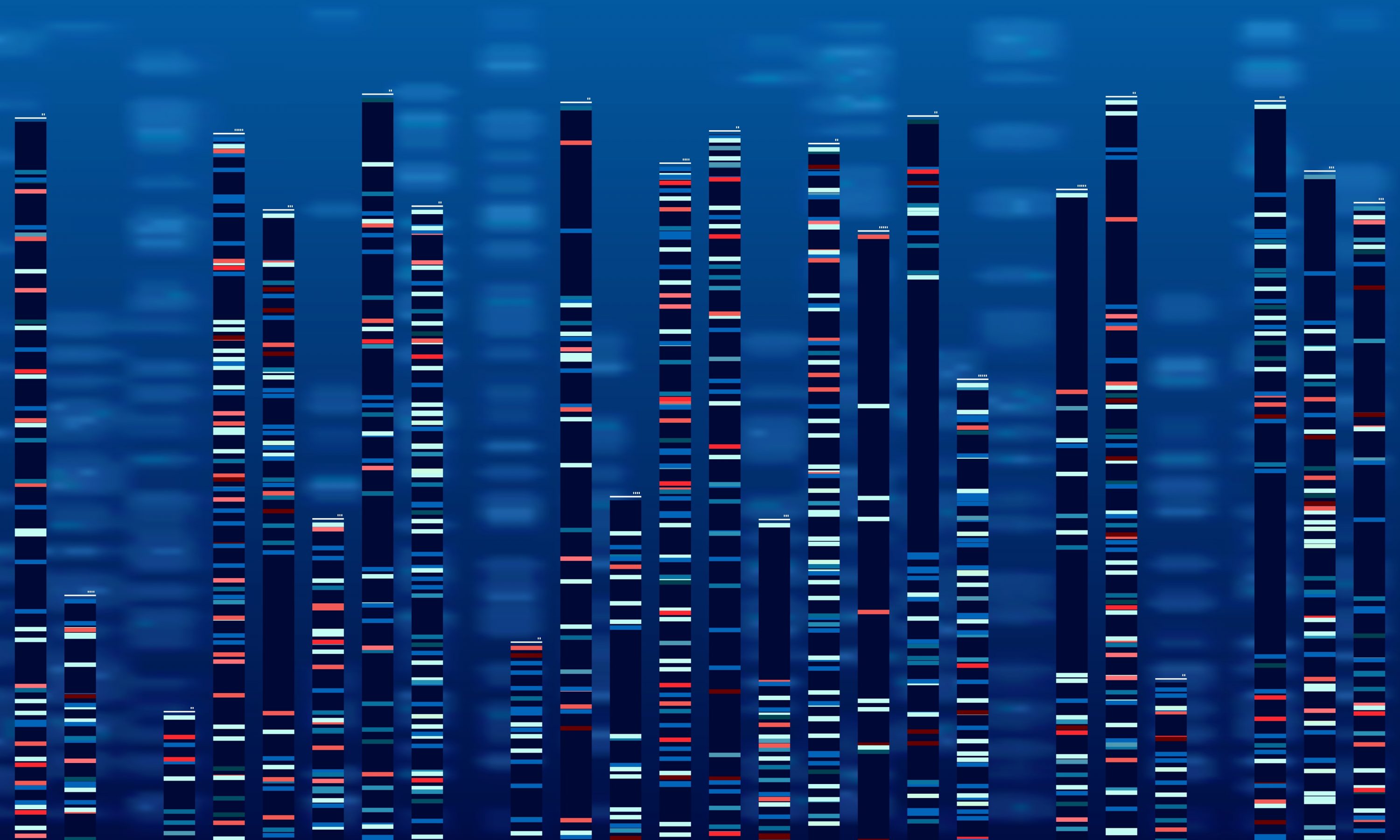Table of contents
- Introduction
- Patent Portfolio of the Asserted Patents and Their Extended Family Members
- Quality Issues of The Asserted Patents
- The Technology Licensed From Harvard Is Highly Similar To A Pre-existing Patented Invention of NanoString
- Conclusion
Introduction
The legal fight between 10x Genomics and NanoString Technologies has intensified. 10x Genomics is a California-based biotechnology company specializing in gene sequencing technology. According to its quarterly report, the company filed a patent lawsuit in Germany against its American competitor NanoString on March 9, 2022, following two separate suits in the U.S.
The fight was initiated in May 2021, when 10x sued NanoString in the U.S. District Court of Delaware. 10x alleged that NanoString’s GeoMx digital spatial profiler infringes seven U.S. patents it licensed from Prognosys Biosciences. (U.S. Patent Nos. 10,472,669, 10,662,467, 10,961,566, 10,983,113, 10,996,219, 11,001,878, and 11,008,607) NanoString countersued in December 2021, asking the court to declare non-infringement and invalidity of the seven patents.
In late February 2022, 10x filed another lawsuit against NanoString in the same venue, alleging that NanoString’s CosMx Spatial Molecular Imager infringes U.S. Patent Nos. 10,227,639 and 11,021,737, which 10x licensed from Harvard University.
Taken together, 10x accused NanoString of infringing nine U.S. patents and one European patent. The asserted European patent, EP No. 2,794,928, is a family member of U.S. Patent No. 10,227,639 (the ‘639 patent) — a patent 10x asserted in the February lawsuit.
Using data from the patent solution platform Patentcloud, on May 31, 2022, we present the jurisdictions of the asserted patents and their family members and where the legal battle might extend to.
With patent analytics tools, we evaluated the quality of the nine U.S. patents to try and find if NanoString has patents that might be used to fight back against 10x Genomics. We found a decent number of references that could potentially be used as prior art to challenge the patentability of the nine patents. We also found that part of the technology 10x licensed from Harvard is highly similar to an earlier patented invention of NanoString.
Patent Portfolio of the Asserted Patents and Their Extended Family Members
Besides the lawsuits in the U.S. and Europe, 10x might file suits against NanoString in other jurisdictions. We created a patent portfolio of the ten litigated patents and their extended family members and analyzed the geographic coverage of the portfolio with Due Diligence.
According to the patent analysis, 83 patent applications correspond to the eight patent families in the portfolio.
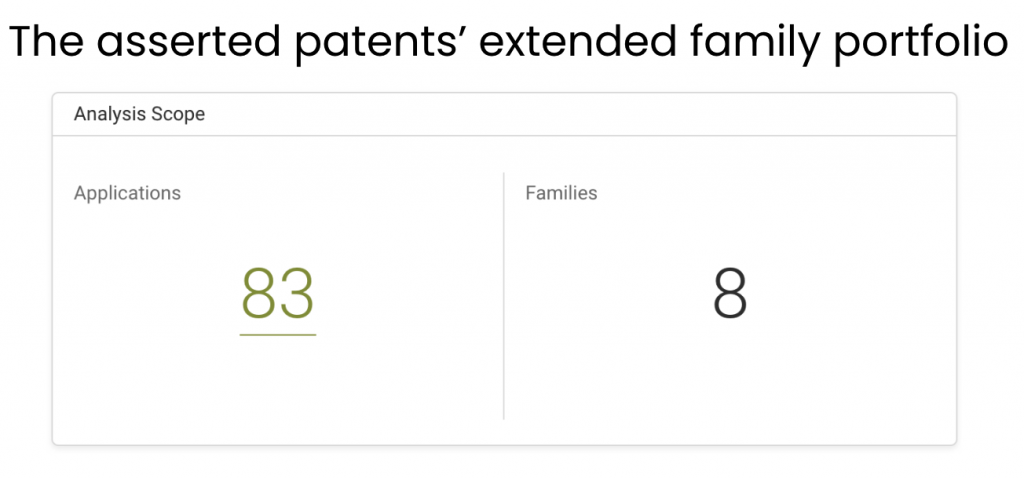
Around 68.68% of the patent applications are active, and 19.28% of the patent applications are pending. The results suggest that the patents-in-suit are critical to 10x’s business, as nearly one out of every five related patent applications are still undergoing examination.

The 57 active patent applications are filed with the following patent offices. The majority of the active applications were filed with the USPTO. The rest of the active patents were filed with Hong Kong’s Intellectual Property Department, European Patent Office, and China National Intellectual Property Administration, just to name a few.

The jurisdiction list of the asserted patents and their extended family members provides insights into where the litigation might extend to. As shown by 10x’s complaint in Germany, 10x is suing NanoString in both the U.S. and Europe. If the two companies decide to settle the disputes with a license agreement, the portfolio patents in the above countries might be included in the terms.
Quality Issues of The Asserted Patents
We looked into the quality of the patents 10x asserted against NanoString. With Quality Insights, we can answer the following questions:
- Have the patents been rejected over prior art under 35 U.S.C. §102 in the prosecution history?
- How are the patent claims disclosed by the examiner’s prior art citation during the prosecution history?
- Are there any highly relevant prior art references that may lead to patentability issues?
Our analysis shows that the majority of the asserted patents were not found with novelty issues during the prosecution. Among the nine U.S. patents 10x asserted, only four of them have novelty issues — they have been rejected over prior art under 35 U.S. Code §102 during the prosecution. (See the column “Novelty Issue” below.) The other five have not been rejected over prior art on the grounds of novelty.

The “Claim Disclosure” in Quality Insights is a measure of how much of a patent’s claims have been disclosed by the prior art references cited in the prosecution history. The four patents with novelty issues are only partially disclosed by the prior art references.
A patent is fully disclosed when all of its claim elements or claim terms can be mapped to the prior art references cited by the patent examiners. A partially disclosed patent does not have all of its claim elements mapped to the prior art references. Generally speaking, a partially disclosed patent is less likely to be found with patentability issues compared to a fully disclosed patent.
Take the U.S. patent 10,227,639, for instance. Looking at the first column, claim #1 is broken down into 12 sub-claims. The “Prior Art Ref.” row shows the prior art references that have been cited to disclose claim #1 during the prosecution. The percentage in each cell shows the proportion of claim elements in the sub-claim that were disclosed by the prior art reference.
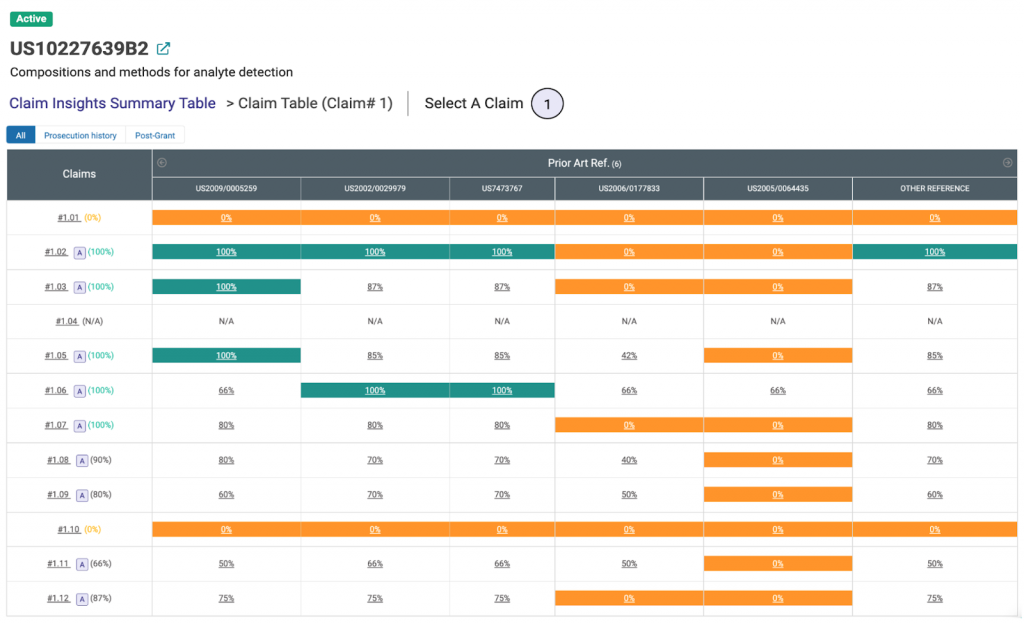

Claim #1.01 is not disclosed by any prior art references used during the prosecution. All the claim elements in claim #1.02 are disclosed by the US2009/0005259, US2002/0029979, US7473767, and other references. By comparing cells column by column, we would be able to identify which prior art references disclose more claim elements.
The following chart shows how the claim elements in a sub-claim are mapped to a prior art reference. The claim elements in claim #1.02 and the same claim elements in one of the prior art references, U.S. Patent No. 7,473,767, are highlighted in blue.
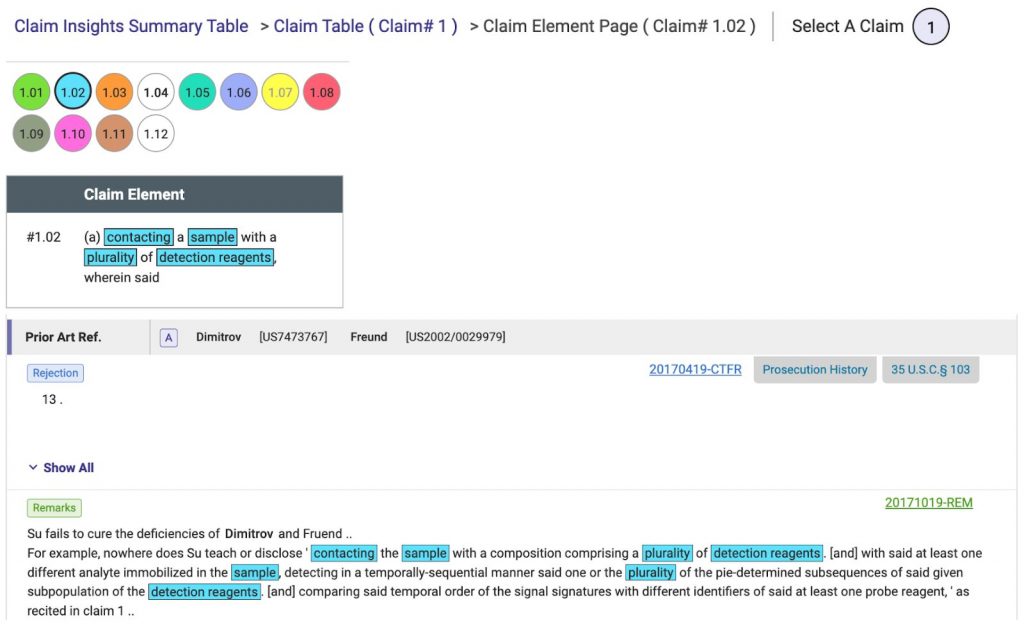
Quality Insights also provides potential prior art references based on novelty citation networks. The prior art references cited by the examiners and used to reject the patents-at-issue during prosecution are first-degree prior art references. Prior art references cited to reject the first-degree prior art references are the second-degree prior art references. In our analysis, the potential novelty prior art references include up to the third-degree prior art.

As suggested by the novelty citation network data, the asserted patents have significant potential §102 prior art issues. On average, the patents 10x asserted against NanoString have around 42.56 potential novelty prior art references.
Only the ‘566 patent and ‘607 patent have less than ten potential novelty prior art references. Even though their numbers of potential prior art references are relatively low compared to other asserted patents, the numbers are still higher than the average.
The Technology Licensed From Harvard Is Highly Similar To A Pre-existing Patented Invention of NanoString
We also found that part of the technology 10x licensed from Harvard is similar to NanoString’s pre-existing invention, as shown by the finding that EPO has cited a NanoString patent as prior art when evaluating the patentability of an asserted Harvard patent. The result suggests it is likely for NanoString to countersue 10x. We illustrate our findings below.
Using Due Diligence, we found two patent applications made by President & Fellows of Harvard College, the legal name of Harvard University, that have been found with novelty issues based on patent examiners’ citations of NanoString patents as prior art. The ID number of the cited NanoString patent family is 43855316. (See the first bar on the left.)
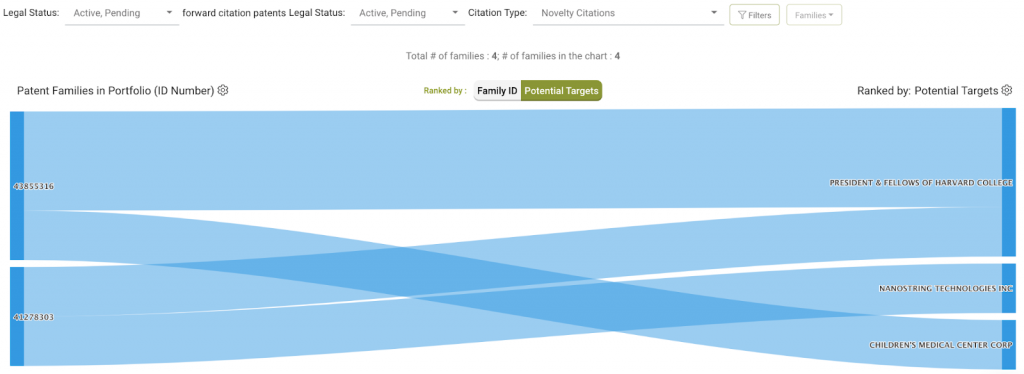
The two Harvard patents are U.S. Patent No. 9,914,958 and European Patent No. 2,794,928 (the EP ‘928 patent.) The latter was licensed to 10x and was claimed to be infringed by NanoString in Germany this March. While 10x claims the EP ‘928 patent is infringed by NanoString, a NanoString patent has been cited as novelty prior art during the prosecution of the ‘928 patent.

Our finding shows that part of the technology Harvard licensed to 10x is highly similar to an earlier invention patented by NanoString. NanoString can use this finding to review 10x’s products to see if the products infringe on its patents. It is possible for NanoString to countersue if 10x is found to be using NanoString’s patented technology.
Conclusion
The results show that the IP fight between 10x and NanoString is far from over. Based on the jurisdictions of the asserted patents and their extended family members, the disputes may arise in other major markets. The legal battle should be watched closely because it may impact both NanoString and 10x.
In the complaint 10x filed in May 2021, the plaintiff asked the Delaware District Court to award permanent injunctions against NanoString. Even though the court has dismissed the claims of indirect infringement and willful infringement, 10x still has time to strengthen its argument before a trial in 2023.
In December 2021, NanoString requested the court to declare non-infringement of the patents 10x asserted in May and that those asserted patents are invalid. If NanoString wins the suit, 10x will no longer enjoy the protection the patent(s) provide, and 10x will need to compete with NanoString’s GeoMx digital spatial profiler on the market.
Our analysis suggests that there is much uncertainty about the 10x Genomics vs. Nanostring patent lawsuits.
Although most of the patents 10x asserted are relatively clean in their prosecution history, the analysis of the novelty citation networks shows numerous highly relevant references have never been cited during the prosecution and could be used as prior art. These references cast uncertainty over the suits between 10x and NanoString.
Finally, while 10x accused NanoString of patent infringement, we found that part of the technology 10x licensed from Harvard is very similar to a pre-existing invention patented by NanoString. The finding adds another layer of complexity to the legal fight.
Find out more about [NanoString’s patent portfolio] in our free demo report.
